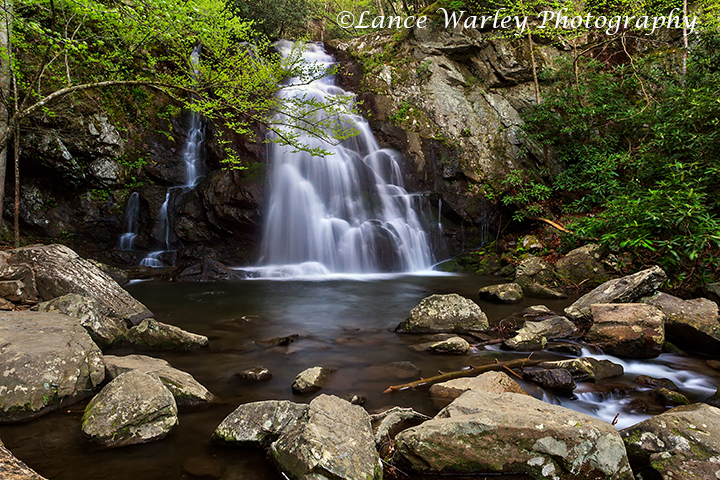|
Spinning Silk
by Lance Warley
A photographer buddy, Mike Cohen, recently asked me what shutter speed I use to create silky water. My fast phone-thumb-mail response: “It depends on the situation, especially the water volume and velocity. I start with the aperture I want for depth of field. Then I set the ISO and shutter speed to get to an exposure with no blown highlights. Then I try different combinations of aperture, shutter speed and ISO to get different looks in the water so I have a choice of shots when I process. In ACR, sometimes it helps to add clarity and reduce contrast.”
If I had taken the time to write a more thoughtful response, I would have mentioned that I always use a polarizer to remove glare, and I always try to work with muted light. Cloudy days are great for water shots. If a scene has direct light, a ND filter may help, but I much prefer soft light.
Mike’s question prompted me to take a look at my water shots’ data. Not surprisingly, the exposures are all over the place. Here’s a consolidated view for a handful of shots, followed by an explanation of what I was trying to do for each image.
| Scene |
f stop |
Shutter Speed |
ISO |
| Avalanche Gorge |
11 |
0.6 |
400 |
| Gooseberry Falls |
13 |
0.4 |
50 |
| Kirkjufell Mountain |
16 |
1/6 |
100 |
| Mountain Island Lake |
16 |
30 |
100 |
| Deerfield Beach |
16 |
Water 1.6
Sky 15 |
Water 200
Sky 50 |
| Porters Creek |
18 |
2 |
160 |
| Spruce Flats Falls |
22 |
0.5 |
1600 |

Avalanche Gorge, Glacier National Park
The gorge is deep and narrow. The water was fast and full. It was dark down there. I started with F16 and a ss of something like 1 second, ISO 100. No good. Pure white. I opened the aperture and increased the ISO to add light, while reducing the ss to capture the details and the feel of the fast-moving flow. I was concerned that F11 wouldn’t give me enough dof, but in the computer the F11 version was the best.

Gooseberry Falls, Minnesota’s North Shore near Lake Superior
At first I didn’t think I had a shot, because the sun was directly on the falls. Then some helpful clouds appeared, thank you very much. I wanted to capture the two tones in the water – the muddy, tannic brown on top, and then the white after the water was cleansed by the middle layer of rocks. ISO 50 worked here, but I’ve stopped using it because it seems to decrease overall dynamic range.

Kirkjufell Mountain, Grundarfjörður, Iceland
Are you kidding me? A triple falls. Ai yi yi. I started shooting at the bottom. I was in the water trying to get a side view that captured space behind and in front of the falls. Then the rock formation on top started glowing from the midnight summer sunset. I ran up to the ledge to create a counterpoint between the falls and the glowing rock. Silk time.

Mountain Island Lake, Huntersville, North Carolina
The clouds were moving fast, and the sunrise was lighting up the band of new Fall colors in the trees. The light was already bright, even though it was just past sunrise, so I used a polarizer, a 6-stop ND and a 3-stop ND to capture the cloud motion. This makes it impossible to see anything through live view or the view finder, so you have to compose and focus first and then try not to move anything when you add the filters. The 30 second exposure also gave the water a smooth texture. If I had used ISO 50, the pastel colors reflected in the water would not have been as rich.

Deerfield Beach, Florida
Like the Mountain Island Lake scene, this had fast moving clouds. The polarizer-ND filter combo worked for the clouds at 15 seconds. But it was too long for retaining details in the incoming waves, which were just as interesting to me as the clouds. So I did a second exposure with just a polarizer at 1.6 seconds for the water and blended them together in PS.

Porters Creek, Great Smoky Mountains National Park
This was a tough one to make. It was raining and I was very close to the jutting rock, barely beyond the 11” minimum focal distance but well within the spray zone. The rain and the spray kept putting water drops on my lens. I wanted to keep the background rocks and trees in focus, especially with the lush green foliage and enchanted light. I didn’t think I could do a focus blend, because the fast moving water and the slippery rocks were making me continually readjust my tripod. So I used F18 while focusing on the jutting rock.

Spruce Flats Falls, Great Smoky Mountains National Park
I expected this to be a two-shot blend, because it was very windy. I took some shots at ISO 1600 to freeze the overhanging branches, and others with a slower shutter speed for the water. Back at the computer, however, it turned out that the ISO 1600 shots gave the best silky look to the water, so I didn’t have to do any blending. Lots of things going on in this comp – the semicircle of rocks, the different color leaves, the smaller falls, the clear water, all complementing the main falls.
My goal is to communicate the water’s texture, it’s “feel.” Photos of drab, featureless water aren’t very interesting, let alone evocative. Standard, predetermined settings won’t work, because each scene has its own conditions. It works best for me to take many different exposures and then have lots of choices for eventually selecting the best one later.
Home | Discuss
|

